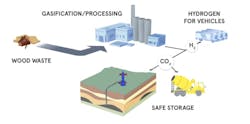Fluor. SunGas helping startup bring Wood Waste-to-Hydrogen plant to West Coast ny 2024
Carbon removal technology firm Mote announced plans to build its first facility near Bakersfield, California that converts wood waste to hydrogen fuel.
The firm is working with engineering and construction firm Fluor Corporation and GTI International subsidiary SunGas Renewables to set up the new plant. The new plant will start production as soon as 2024.
The firms will capture, use and sequester CO2 emissions resulting from the wood waste-to-hydrogen conversion process. Mote thus, estimates that 150,000 metric tons of CO2 will be removed from the air each year while the facility produces 7 million kilograms of carbon-negative hydrogen annually.
Mote co-founder and CEO Mac Kennedy called it the first carbon removal project converting biomass to H2.
“As the world’s first carbon removal project converting biomass to hydrogen, we are addressing the ever-growing demand for renewable hydrogen with a carbon-negative approach," Kennedy said. "Our pioneered technology directly supports California in its carbon-neutrality goals by removing carbon dioxide from the atmosphere with our wood waste conversion process. With this new facility, Mote is laying the groundwork for affordable hydrogen offerings on a global scale while also supercharging natural carbon removal processes.”
Mote will use wood waste from forestry, farms and other resources, which may be burned or sent to landfills. It will leverage Fluor’s expertise to integrate proven equipment and SunGas Renewables’ gasification systems into the Mote California Central Valley Project. The gasification and treatment processes will be used to remove CO2 and store it safely underground.
After spending the last 20 years researching carbon capture and clean energy, it's amazing to have a solution that can address both and even divert waste to a beneficial use,” said Dr. Stolaroff, Chief Technology Officer of Mote.
Mote will contribute to reversing climate change through its biomass-to-hydrogen process.
“This is exactly the kind of project we need to meet our climate goals at a reasonable cost,” added Roger Aines, Chief Scientist of the Energy Program at the Lawrence Livermore National Laboratory. “Mote understands the energy system, and they are making a smart play for long-term impact.”
Additionally, Mote is in talks with carbon utilization firm CarbonCure Technologies on storing the captured CO2 in concrete through its carbon removal technologies, which are in use at concrete plants worldwide.
About the Author
EnergyTech Staff
Rod Walton is senior editor for EnergyTech.com. He has spent 17 years covering the energy industry as a newspaper and trade journalist.
Walton formerly was energy writer and business editor at the Tulsa World. Later, he spent six years covering the electricity power sector for Pennwell and Clarion Events. He joined Endeavor and EnergyTech in November 2021.
He can be reached at [email protected].
EnergyTech is focused on the mission critical and large-scale energy users and their sustainability and resiliency goals. These include the commercial and industrial sectors, as well as the military, universities, data centers and microgrids.
Many large-scale energy users such as Fortune 500 companies, and mission-critical users such as military bases, universities, healthcare facilities, public safety and data centers, shifting their energy priorities to reach net-zero carbon goals within the coming decades. These include plans for renewable energy power purchase agreements, but also on-site resiliency projects such as microgrids, combined heat and power, rooftop solar, energy storage, digitalization and building efficiency upgrades.
